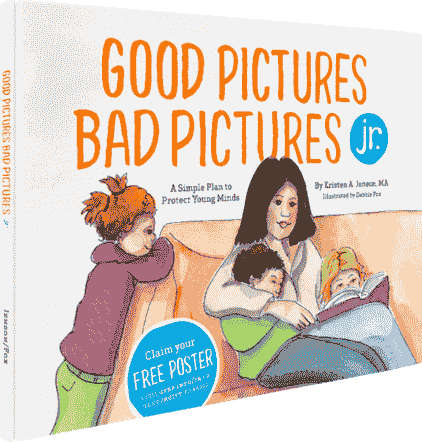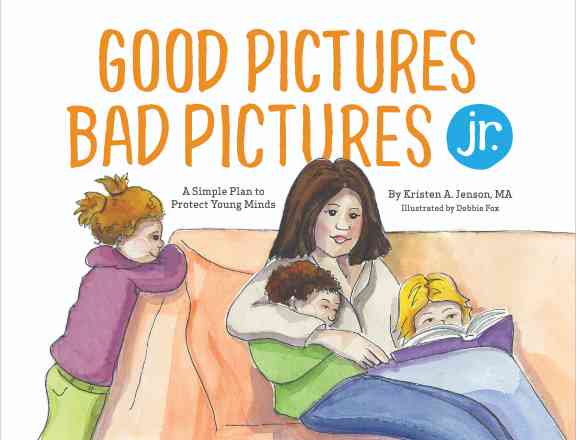.jpg)
.jpg)
Good Feelings Bad Feelings: Helping Kids Decode Pornography’s Tricky Dual Emotions
This article was originally published 2/5/2019 and updated on 9/12/2023
I remember the first time I saw pornography. You probably do, too.
I was nineteen, at a bachelorette party, and very confused by my emotions at the time. I felt caught between arousal and disgust as I watched the scenes unfold before me. How could something that initially sent a rush of good feelings leave me feeling so gross inside?
.jpg)
These days, children a decade younger than I was have been exposed to content that may be even more shocking. If I was bewildered at the age of nineteen, how much more are they?
Pornography exploits natural feelings
Here’s the plain truth: Sexual activity is supposed to feel good. Those good feelings are actually a sign that our bodies are working just the way they were meant to. If procreation required activity that we didn’t enjoy, our species would come to end rather quickly. (Side note: I know that not all people derive pleasure from sexual activity. Much of that happens because of hurtful things, such as abuse. Here, I am talking about the intended design of our bodies.)
Unfortunately, viewing pornography activates the same hormones that sexual connection with another human does. This arousal sends the “This feels good! Let’s keep doing it!” signal to the brain.
But instead of deepening a relationship with another person or creating a new life, all that remains is a confused child who doesn’t understand the opposing feelings within his or her body. What are these the dual emotions? Many kids say that although they may feel excited, interested and attracted at the outset, they also feel “yucky” or “sick to their stomach.”
Acknowledge dual feelings viewing porn evokes
It’s common for internet safety educators to advise kids to get help from a trusted adult if they see anything online that is confusing, that they know is wrong, or when something feels “off”.
When we don’t explain that pornography can create both bad feelings and good feelings at the same time, kids may feel like there is something wrong with them. They may decide they are bad kids because they had good feelings watching bad things. And they may hide in shame instead of reaching out for help.
Related: How Porn Hijacks Young Brains and 3 Effective Ways to Defend Your Kids (Part 2)
The highs of pornography
Even when kids have not started puberty, they can still be affected by viewing pornography. Kids as young as eight years old have contacted Fight the New Drug for help stopping their porn viewing. Even kids too young to experience sexual feelings may continue watching simply out of curiosity. It’s their job to grow up and become an adult, so they try to figure out what grown-ups do.
Girls can start puberty as early as eight years old, while most boys don’t start until age ten. That’s still pretty young. Pornography goes to extreme lengths to activate those “feel good” hormones so kids get hooked early and keep coming back for more. That’s why one in 10 children have watched pornography by the age of 9.
This is the high of porn.
Related: How Porn Corrupts the Brain’s Reward System: Neurosurgeon Explains
The lows of pornography
While our kids have sexual feelings, they also have a developing conscience. They are beginning to understand ethical choices of right and wrong, such as what is fair and how to treat others.
Just as porn turns on their sexual interest, it also activates their conscience. This is why kids say they feel upset after viewing pornography. This physical feeling is tied to emotional responses such as:
- Shock and even trauma from being exposed to explicit sexual activity at a young age. (Even lots of adults find it disturbing.)
- Shame from watching nudity and sexual behavior, which kids know should be private. Then they often feel they are a bad kid themselves.
- Sadness from seeing the mistreatment of another human being.
- Fear that something bad could happen to them or someone they love.
- Guilt if they broke the rules in their family or school.
- Anxiety because they are worried they will get in trouble.
This is the low of porn.
Related: 5 Proven Ways Porn Harms Kids that No One Talks About
The emotional collision instigated by porn
To illustrate just one of these emotional responses, consider that we tell our children the importance of modesty. We teach them to keep their clothes on in public and shut the door to the bathroom. We train them to protect their bodies, that no one should touch their private areas. We share appropriate affection with our spouses around the kids and keep sexual intimacy private behind a closed and locked door.
But with pornography, it’s all laid bare for anyone to see. Kids know that what they are watching, they shouldn’t be. Another collision of emotions.
[[CTA]]
From confused to confident
As adults, we know it can be challenging to reconcile conflicting emotions. We want the brownie, but we also want to lose weight. We want a brand new car, but we also want to get out of debt. We want to manage time productively, but we get sucked in by social media. Wanting opposing things is hard to manage at any age!
Remembering this, we can help our children navigate the trickiness of porn. Here are some tips to help you E.N.G.A.G.E. and guide them as they untangle their confusing feelings.
- Empathize: Your child already feels horrible. Shame elicits the desire to hide — and this is the last thing you want when it comes to pornography. Instead, empathize with them. Talk about mistakes you made that made your stomach hurt. Affirm that they are not defined by what they have seen. Reassure them that you love them and will be there for them.
- Normalize: It’s so important for kids to know their sexual feelings are normal and good. Let them know it’s how their bodies are designed, and that you are glad they have these good and powerful feelings. Share the reasons why we have these feelings. Reinforce your family’s values about appropriate ways to express sexual feelings as they grow and when dating and marrying.
- Guard: Talk about working together for better online safety. What were the circumstances that surrounded the encounter with pornography? What ideas do they have to help them stay safe? What can you do as a parent to guard their safety?
- Agree: Come to an agreement that pornography is harmful for them. Why is seeing pornography making them feel so down and distressed? Those bad feelings are a sign that they are a good person who recognizes when something is wrong. Even young kids understand the value of people. You can explain that watching porn affects how they think about others. Teach your kids about the detrimental effects of porn, adapted for their age. Here’s an overview of some of the harmful effects of porn.
- Give: Give your child tools for what to do when they encounter it again. Make sure to check out the Good Pictures Bad Pictures read aloud book series that offers age appropriate ways to discuss porn with children. Here children will learn a definition, a warning, and a plan. Brainstorm ideas on how to handle it if they ever feel tempted to seek out porn. Can they ask you to do something? Go outside and play? Call a friend?
- Encourage: Encourage your child to keep coming back to you. They can ask questions. They can tell you they’ve seen something bad. They can turn to you when their friends are pressuring them. Open communication is critical to connection with your child. The more meaningful relationships they have, the less likely they will seek after porn and other addictive substances.
Related: 3 Steps to Give Kids an Internal Filter
As a parent, I totally get that talking to your kids about their sexual feelings is awkward. It can feel safer to ignore the natural and healthy sexual development of our kids, and just focus on how bad pornography is. Getting past our discomfort and talking openly about both the good and bad feelings that come with pornography gives your kids power to manage their emotions. Building a support system and healthy communication that will last for years to come makes it all worth it.
.jpg)


Good Pictures Bad Pictures Jr.
“I highly recommend this book to all people with children. A must have for all parents!” —Amazon Review
.jpg)
.jpg)






